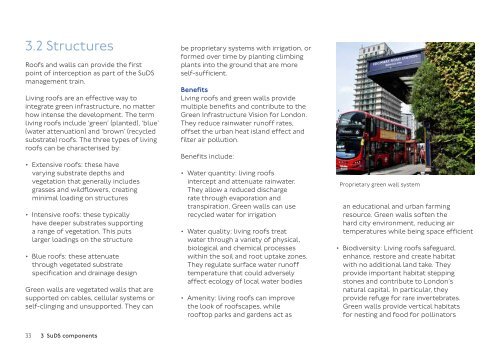SuDS in London - a guide
sustainable-urban-drainage-november-2016
sustainable-urban-drainage-november-2016
You also want an ePaper? Increase the reach of your titles
YUMPU automatically turns print PDFs into web optimized ePapers that Google loves.
3.2 Structures<br />
Roofs and walls can provide the first<br />
po<strong>in</strong>t of <strong>in</strong>terception as part of the <strong>SuDS</strong><br />
management tra<strong>in</strong>.<br />
Liv<strong>in</strong>g roofs are an effective way to<br />
<strong>in</strong>tegrate green <strong>in</strong>frastructure, no matter<br />
how <strong>in</strong>tense the development. The term<br />
liv<strong>in</strong>g roofs <strong>in</strong>clude ‘green’ (planted), ‘blue’<br />
(water attenuation) and ‘brown’ (recycled<br />
substrate) roofs. The three types of liv<strong>in</strong>g<br />
roofs can be characterised by:<br />
• Extensive roofs: these have<br />
vary<strong>in</strong>g substrate depths and<br />
vegetation that generally <strong>in</strong>cludes<br />
grasses and wildflowers, creat<strong>in</strong>g<br />
m<strong>in</strong>imal load<strong>in</strong>g on structures<br />
• Intensive roofs: these typically<br />
have deeper substrates support<strong>in</strong>g<br />
a range of vegetation. This puts<br />
larger load<strong>in</strong>gs on the structure<br />
• Blue roofs: these attenuate<br />
through vegetated substrate<br />
specification and dra<strong>in</strong>age design<br />
Green walls are vegetated walls that are<br />
supported on cables, cellular systems or<br />
self-cl<strong>in</strong>g<strong>in</strong>g and unsupported. They can<br />
be proprietary systems with irrigation, or<br />
formed over time by plant<strong>in</strong>g climb<strong>in</strong>g<br />
plants <strong>in</strong>to the ground that are more<br />
self-sufficient.<br />
Benefits<br />
Liv<strong>in</strong>g roofs and green walls provide<br />
multiple benefits and contribute to the<br />
Green Infrastructure Vision for <strong>London</strong>.<br />
They reduce ra<strong>in</strong>water runoff rates,<br />
offset the urban heat island effect and<br />
filter air pollution.<br />
Benefits <strong>in</strong>clude:<br />
• Water quantity: liv<strong>in</strong>g roofs<br />
<strong>in</strong>tercept and attenuate ra<strong>in</strong>water.<br />
They allow a reduced discharge<br />
rate through evaporation and<br />
transpiration. Green walls can use<br />
recycled water for irrigation<br />
• Water quality: liv<strong>in</strong>g roofs treat<br />
water through a variety of physical,<br />
biological and chemical processes<br />
with<strong>in</strong> the soil and root uptake zones.<br />
They regulate surface water runoff<br />
temperature that could adversely<br />
affect ecology of local water bodies<br />
• Amenity: liv<strong>in</strong>g roofs can improve<br />
the look of roofscapes, while<br />
rooftop parks and gardens act as<br />
Proprietary green wall system<br />
an educational and urban farm<strong>in</strong>g<br />
resource. Green walls soften the<br />
hard city environment, reduc<strong>in</strong>g air<br />
temperatures while be<strong>in</strong>g space efficient<br />
• Biodiversity: Liv<strong>in</strong>g roofs safeguard,<br />
enhance, restore and create habitat<br />
with no additional land take. They<br />
provide important habitat stepp<strong>in</strong>g<br />
stones and contribute to <strong>London</strong>’s<br />
natural capital. In particular, they<br />
provide refuge for rare <strong>in</strong>vertebrates.<br />
Green walls provide vertical habitats<br />
for nest<strong>in</strong>g and food for poll<strong>in</strong>ators<br />
33 3 <strong>SuDS</strong> components


